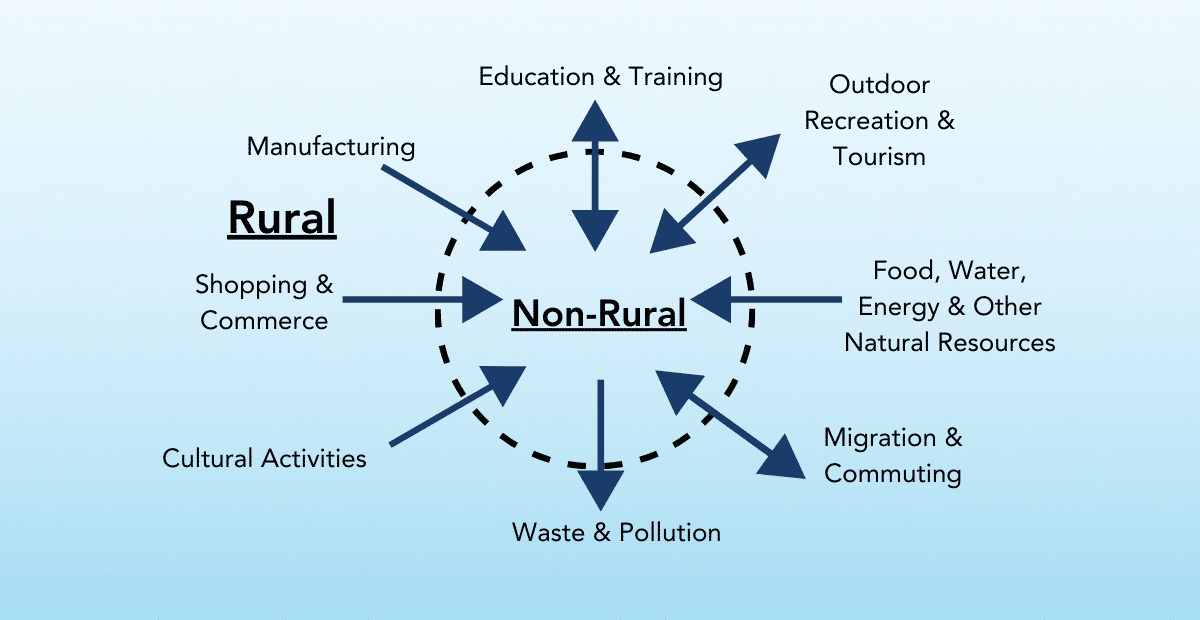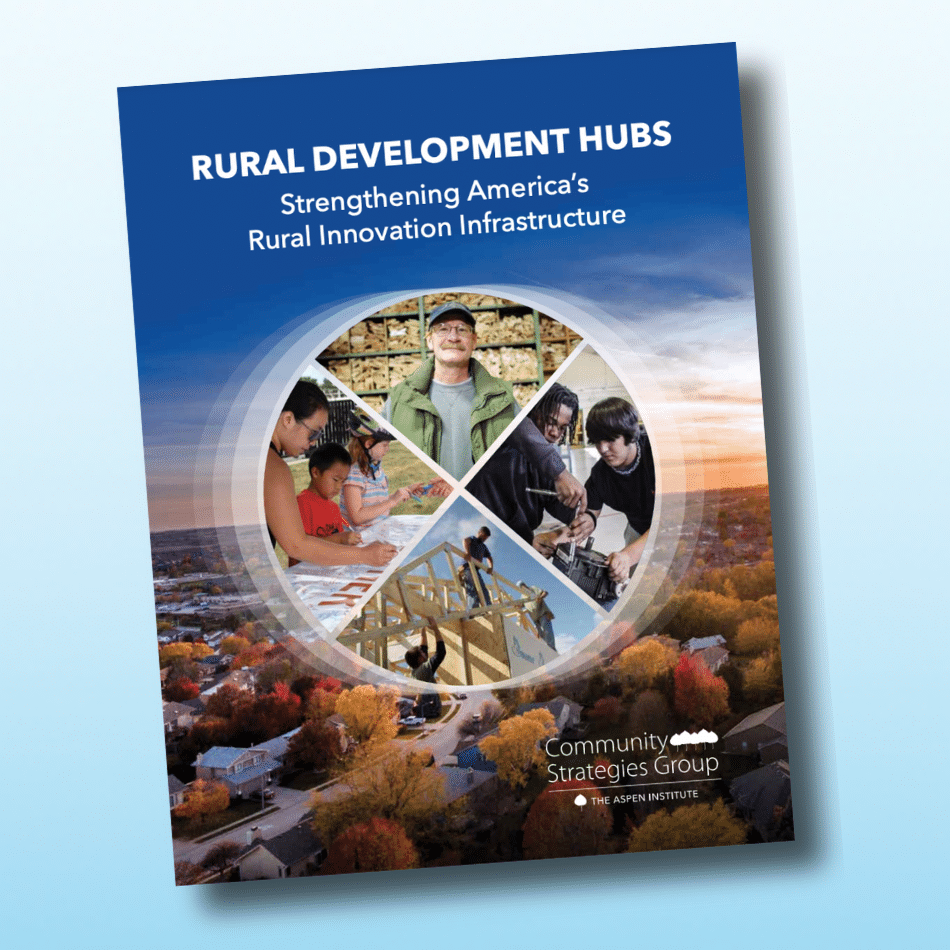At Aspen CSG, we are committed to fostering positive, equity-centered, and asset-based rural narrative change. This blog shares our current thinking, related resources, and upcoming opportunities to help advance this critical work.
Why Narrative Change Matters
Rural narratives shape how communities are perceived and valued—affecting public opinion, policy decisions, and investment priorities. At Aspen CSG, we work to amplify positive and truthful narratives about rural America, informed by the voices and lived experiences of rural leaders and practitioners across diverse regions.
Our Thrive Rural Framework positions narrative as a cornerstone of systems-level change. Specifically, the Accurate Rural Narrative building block describes narrative change as how rural people, places, and economies are represented more fairly and fully in media, policy, and public discourse. This means challenging deficit-based stereotypes—such as portraying rural areas as monolithic, struggling, or “white farmers and red barns”—and instead celebrating rural communities’ diversity, resilience, and contributions.
Narratives are not merely stories—they are systems-level levers. They shape resource allocation, influence policy priorities, and impact community pride. Moving toward equity-centered, asset-based narratives strengthens rural momentum and helps unlock investments and opportunities critical to building vibrant, inclusive economies.
Rural Narrative Change: A Long-Term Endeavor
Transforming narratives about rural America is a complex, long-term process that requires collaboration, persistence, and intentionality. As narrative change thought leaders Mandy Van Deven and Jody Myrum emphasize, this work is inherently a collective endeavor that relies on partnerships across local, regional, and national levels.
Aspen CSG has supported rural narrative change since 1985 through tools and resources that amplify truthful stories. Recent examples include:
- Glossaries in Reports: To promote clarity and equity in language (e.g., page 4 of Mapping a New Terrain).
- Thrive Rural Network Resource Center: Sharing partner resources illuminating the intersectional rural development themes.
- Equity Ground Truthing: Working closely with our Rural Action Roundtable on Equity (RARE) to align our narrative work with the lived realities of diverse rural communities.
Despite progress, systemic challenges persist. Current federal policy proposals often focus narrowly on rural infrastructure or direct services without addressing deeper inequities or fostering diversified economies. Narrative change must accompany these development efforts to reframe how rural is understood and valued at a systems level.
Key Facts About Rural America
- Rural is BIG: Rural America spans 97% of the US landmass and is home to 19.3% of the population, approximately 60 million people (Census).
- Rural diversity: In 2020, 1 in 4 rural Americans were people of color, up from 20% in 2010 (UNH).
- Indigenous representation: 2.7 million Native Americans, Alaska Natives, and Native Hawaiians live in rural areas, comprising 4.9% of the rural population (CORI).
- Poverty disparities: 8 in 10 persistent poverty counties are rural, most of which are majority people of color (PRT).
- Childhood poverty rates: 21.1% of rural children live in poverty, compared to 16.1% of urban children (USDA).
- Disability rates: Rural residents are 14.7% more likely to live with a disability than urban residents (Census).
- Economic diversity: Agriculture is only about 7% of the overall employment in rural economies across the country (USDA / The Federal Reserve).
Values-Driven Narrative Change
Aspen CSG’s approach to rural narrative change is deeply rooted in our organizational values: Equity, Collaboration, and Learning. These values guide every aspect of our work, ensuring that we address systemic challenges while amplifying the assets, resilience, and opportunities for growth within rural and Indigenous communities.
Equity
Equity lies at the heart of rural narrative change. Systemic inequities based on race, place, and class have long influenced policies, investments, and perceptions, perpetuating harmful stereotypes and reinforcing underinvestment—particularly in communities of color and Native nations. By centering equity, we challenge historical narratives that overlook or misrepresent rural diversity and complexity.
To address these inequities, Aspen CSG prioritizes:
- Inclusive language and storytelling: We emphasize narratives highlighting the contributions of Black, Indigenous, Latinx, and immigrant communities in rural areas. These groups are vital to rural America’s social and economic fabric, yet their stories are often overlooked in mainstream portrayals.
- Challenging stereotypes: Accurate rural narratives go beyond farmland and red barns. Our imagery and storytelling reflect the diversity of rural life—featuring people, working landscapes, and dynamic small-town economies.
- Equity-centered advocacy: We push for policies and investments that dismantle barriers and prioritize resources for communities most impacted by systemic disinvestment.
Equity is not just about representation; it’s about creating space for all rural voices to be heard, valued, and reflected in the national narrative.
Collaboration
Narrative change is a collective effort that thrives on local, regional, and national partnerships. By fostering collaboration, we can align diverse stakeholders around a shared vision for rural prosperity. At Aspen CSG, we prioritize regionalism, knowing that the interconnectedness of rural and non-rural economies and communities often demands joint action.
Aspen CSG’s collaborative efforts include:
- Regional stories and tools: We share examples of successful regional collaboration, such as those from WealthWorks, to demonstrate how asset-based, collective approaches can build stronger, more sustainable rural economies.
- National coordination: Through the continued support of the Robert Wood Johnson Foundation, we’ve coordinated a cohort of other grantees to help align messaging and narrative of what’s working in rural communities across geographies and issue areas.
- The Rural Communications Group: This network convenes national rural-serving organizations to coordinate messaging, share resources, and elevate the diverse realities of rural life through joint campaigns and collective storytelling.
In addition to our own work, Aspen CSG celebrates and amplifies the work others have done to build momentum for narrative change. Some examples we encourage you to check out include The Partners for Rural Transformation’s Stories of Rural America, Native Americans in Philanthropy language guide, The Center on Rural Innovation’s Rural Aperture Project, and many great podcasts originating from and focusing on rural areas.
Learning
Change is an iterative process, and learning is integral to our work. We embrace an emergent learning approach, adapting to the evolving needs of rural communities while integrating insights from practitioners and leaders in the field.
Key examples of this learning approach include:
- Thrive Rural Framework: The framework exemplifies our commitment to learning—it was developed not as a static blueprint but as a dynamic tool shaped by ongoing input from the field.
- Thrive Rural Action Learning (TRALE): We strategically build our invite lists to these action-learning sessions to bring together a diverse group of rural leaders to co-create solutions. Over the last five sessions, we’ve achieved over 50% participation from people of color, including 18% Indigenous attendees. We compensate participants to ensure equitable involvement and recognize the expertise they bring.
- Rural Development Hubs: Coined by Aspen CSG in 2019, this concept describes place-rooted organizations collaborating across regions to build inclusive wealth and create opportunities for equitable prosperity. The Hubs model reflects the power of grassroots expertise and shared learning. Rural leaders’ insights and experience shaped our Hubs research, and the Hubs report gave rural leaders a language and concept to legitimize and popularize their transformational work for the first time.
Our learning strategy is rooted in listening to the voices of rural residents. We strive not to present ourselves as the “experts” but rather acknowledge one of the major lessons of emergent learning – that each and every one of our action-learning participants has expertise in equal measure. Aspen CSG ensures that our work reflects their diverse realities, hopes, and challenges by maintaining continuous dialogue with rural communities. This approach helps us avoid top-down narratives and instead fosters stories that honor the dignity and richness of rural life.
This commitment to elevating rural voices defines Aspen CSG’s role as a national “hub of hubs.” We translate the knowledge and perspectives of rural field leaders into actionable narrative change that shapes systems and policies. For example, over the past five years, the concept of Rural Development Hubs—coined by Aspen CSG—has gained traction among federal agencies, private capital, and philanthropy. More importantly, this narrative shift has influenced investors to make smarter, more targeted investments in regional hub organizations, supporting equitable rural prosperity at scale.
Narrative Change as a Transformative Force
By grounding our efforts in equity, collaboration, and learning, we aim to shift the narrative from one of deficits and stereotypes to one of possibility, resilience, and opportunity. Narrative change is not just about public perception—it’s a transformative force that shapes policy priorities, attracts investment, and fosters a sense of belonging and pride in rural communities.
For example, sharing stories of rural ingenuity, such as cooperative broadband projects or Indigenous-led economic initiatives, reveals the strength and creativity within rural communities—despite chronic underinvestment and extractive industries. These stories not only counter stereotypes but also inspire action and investment.
Ultimately, our values-driven approach positions rural narrative change as a critical lever for achieving systemic equity and prosperity. Together, we can build a future where all rural people, places, and economies are recognized as vital, vibrant, and valued. Join us in telling a more accurate story of rural America together.







